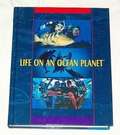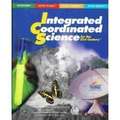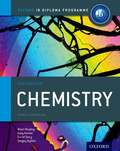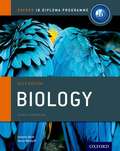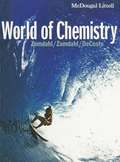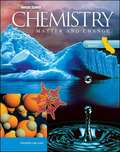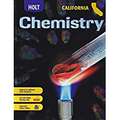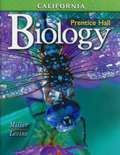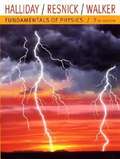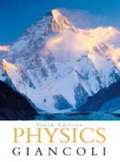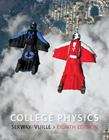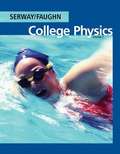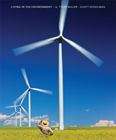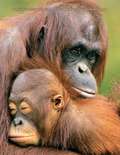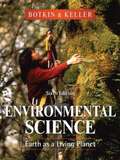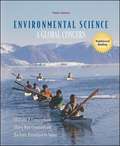Special Collections
District List: LAUSD High School Williams List of District Adopted and Approved Textbooks
- Table View
- List View
Integrated Coordinated Science for the 21st Century
by Gary Freebury and Ruta Demery and Robert Ritter and Arthur Eisenkraft and John B. Southard and Michael SmithIntegrated Coordinated Science for the 21st Century is an innovative core curricula assembled from four proven inquiry-based programs.
Oxford IB Diploma Programme
by Sergey Bylikin and Gary Horner and Brian Murphy and David TarcyThis book is a companion for students of Chemistry in the International Baccalaureate Diploma Programme.
IB Biology Course Book
by Andrew Allott and David MindorffThe only diploma program biology resource developed with the IB to accurately match the new 2014 syllabus for both SL and HL. This revised edition gives you unparallelled support for the new concept-based approach to learning: the Nature of science. Understanding, applications and skills are integrated in every topic, alongside TOK links and real-world connections to drive inquiry and independent learning. Assessment support directly from the IB, includes practice questions and worked examples in each topic, along with focused support for both the Internal Assessment and Extended Essay. Truly aligned with the IB philosophy, this course book gives unrivalled insight and support at every stage. · Written by co-authors of the new syllabus and leading IB workshop leaders · Accurately cover the new syllabus - the most comprehensive match, with support directly from the IB on the core, AHL and all the options · Fully integrate the new concept-based approach, holistically addressing understanding, applications, skills and the Nature of science · Tangibly build assessment potential with assessment support straight from the IB · Develop confidence - data-based questions and focused practice support exceptional achievement · Supported by a fully comprehensive and updated Study Guide About the Series: IB Diploma Course Books are essential resource materials designed in cooperation with the IB to provide students with extra support through their IB studies. Course Books provide advice and guidance on specific course assessment requirements, mirroring the IB philosophy and providing opportunities for critical thinking.
World of Chemistry
by Steven S. Zumdahl and Susan L. Zumdahl and Donald J. DecosteNIMAC-sourced textbook
World of Chemistry (Second Edition)
by Steven S. Zumdahl and Susan L. Zumdahl and Donald J. DecosteWorld of Chemistry presents the right balance of concepts and applications, emphasizing active learning and encouraging students to solve problems creatively.
Chemistry
by Laurel Dingrando and Kathleen Tallman and Nicholas HainenMeets All California State Standards!Glencoe CaliforniaChemistry: Matter and Changecombines the elements students need to succeed! A comprehensive course of study designed for a first-year high school chemistry curriculum, this program incorporates features for strong math support and problem-solving development. Promote strong inquiry learning with a variety of in-text lab options, including Discovery Labs, MiniLabs, Problem-Solving Labs, and ChemLabs (large- and small-scale), in addition to Forensics, Probeware, Small-Scale, and Lab Manuals. Provide simple, inexpensive, safe chemistry activities with Try at Home labs. Unique to Glencoe, these labs are safe enough to be completed outside the classroom and are referenced in the appropriate chapters!
Holt Chemistry (California Edition)
by R. Thomas Myers and Keith B. Oldham and Salvatore TocciHolt Chemistry California is in line with California test standards. In this book you will see three things: what the standard actually says, what it means, and an explanation to help you understand it.
Active Chemistry
by Arthur Eisenkraft and Gary Freebury and American Institute of Chemical Engineers Staff and It'S About TimeActive Chemistry makes learning chemistry relevant, fun, and exciting. Chemistry is involved in every aspect of your life - from the way your body works to the things you like to do.
Prentice Hall Biology (California Edition)
by Kenneth R. Miller and Joseph S. LevineBiology isn't just a "subject" in school. Biology is the science of life itself. Biology is the study of what makes an eagle fly, a flower bloom, or a caterpillar turn into a butterfly. It's the study of ourselves--of how our bodies grow and change and respond to the outside world, and it's the study of our planet, a world transformed by the actions of living things. All organisms interact with one another and with the environment in ways that create our planet's web of life. Organisms make tropical rain forests and coral reefs, prairies and swamps--and farms and cities. Our interactions involve not only each other--but also the winds and ocean currents that tie our planet together. Human activity can change, and is changing, local and global environments in ways that alter our ability to produce food and protect ourselves from diseases. We are one on the global ecological level.
Biology (California)
by Stephen Nowicki"The 21st century will be the century of biological science, just as the 20th century was the century of physical science," predicts Professor Stephen Nowicki, an award-winning teacher at Duke University. Dr. Nowicki has adapted his acclaimed introductory biology course for The Teaching Company to bring you up to date on one of the most important fields of knowledge of our time and help you appreciate the marvelous diversity and complexity of life. You will obtain the background and guidance to explore in depth the fundamental principles of how living things work-principles such as evolution by natural selection, the cellular structure of organisms, the DNA theory of inheritance, and much more. This challenging course is organized around three major themes: "Information and Evolution," "Development and Homeostasis," and "Energy and Resources." You will explore living systems at all levels, from biological molecules to global ecosystems. You will gain insight into pressing issues facing society, including genetic modification and cloning, stem-cell research, AIDS, the depletion of the rainforests, and global warming. You will discover mechanisms behind such intriguing phenomena as why children resemble their parents, why plants bend toward light, how memories are stored, why some birds have very long tails, and how life itself began on Earth. Above all, you will learn how to think about biology, so that in your day-to-day life you will understand the significance and complexities of news stories, medical issues, and public debates, not to mention what is going on in your own garden and in nature all around you.
Fundamentals of Physics (7th edition)
by David Halliday and Robert Resnick and Jearl WalkerNo other book on the market today can match the 30-year success of Halliday, Resnick and Walker's Fundamentals of Physics! In a breezy, easy-to-understand style the book offers a solid understanding of fundamental physics concepts, and helps readers apply this conceptual understanding to quantitative problem solving. This book offers a unique combination of authoritative content and stimulating applications.
Physics
by Douglas C. GiancoliThis algebra-based physics text contains many intriguing applications, including airbags, bungee jumping, photocopiers, highway mirages, and computer hard drives. The pedagogy has been updated to reflect new research on how students learn. Consequently, chapters now include two or three conceptual examples--each a sort of brief Socratic question and answer. Estimating examples show how to make order-of-magnitude estimates even when the data are scarce.
Physics, AP* Edition (3rd Edition)
by James S. WalkerPhysics determines the behavior of everything in the universe--from the particles that make up atoms, to the tissues of the human body, to galaxies and the multitude of stars they contain. Grouped in pairs that share a common physical theme, these images touch on just a few of the many real-world applications of physics discussed in this text. As you study the material in this book, your understanding of physics will deepen. You will begin to make the connection between magnets and MRI, organ pipes and windpipes, lighthouses and magnifying glasses, hurricanes and galaxies. At the same time, your appreciation for the world around you will increase as you come to recognize the fundamental physical principles on which all of our lives are based.
College Physics (8th Edition)
by Raymond A. Serway and Jerry S. Faughn and Chris VuilleSerway (emeritus, James Madison U. ) and Vuille (Embry-Riddle Aeronautical U.) update yet again their textbook for a one-year introduction to physics for majors in biology, the health professions, environmental and social sciences, and technical fields such architecture. It uses algebra, geometry, and trigonometry but not calculus. The goal is for students to acquire a clear and logical understanding of the basic concepts and principles of physics, and some idea about how those can be applied to, and demonstrated from, aspects of daily life. This edition is fully integrated with Enhanced WebAssign. It covers mechanics, thermodynamics, vibrations and waves, electricity and magnetism, light and optics, and modern physics. Annotation ©2011 Book News, Inc., Portland, OR (booknews.com)
College Physics
by Raymond A. Serway and Chris Vuille and Jerry S. FaughnIntended for biology and social science students, this two-semester textbook explains Newtonian mechanics, the physics of fluid, heat and thermodynamics, wave motion and sound, the concepts of electricity and magnetism, the properties of light, relativity, and quantum physics. The eighth edition eliminates superfluous worked examples and adds sections on thermal processes and magnetic materials. Annotation ©2008 Book News, Inc. , Portland, OR (booknews. com)
College Physics
by Raymond A. Serway and Jerry S. Faughn and Chris Vuille and Charles A. BennettNIMAC-sourced textbook
Living in the Environment
by Scott E. Spoolman Jr. and G. Tyler MillerIn this current, thought-provoking environmental science textbook, G. Tyler Miller and new coauthor Scott Spoolman bring the concept of sustainability to the forefront. Students are engaged and motivated with vivid case studies and hands-on quantitative exercises. As the authors showcase four scientific principles of sustainability, they immerse students in the many practical steps they, as individuals, can take toward more sustainable lifestyles. The book's new concept-centered format transforms complex environmental topics and issues into key concepts that students will understand and remember.
Environmental Science
by Daniel B. Botkin and Edward A. KellerUpdated and revised to include the latest research in the field, the new Sixth Edition of Environmental Science continues to present a balanced analytical and interdisciplinary approach to the field. This approach equips readers with a solid scientific background in environmental science, so they can think through environmental issues and make their own decisions. Five central themes are weaved throughout the book: Human Population Growth, Sustainability, A Global Perspective, An Urban World, and Science and Values.
Environmental Science
by Daniel B. Botkin and Edward A. KellerAn introductory textbook that presents the most important concepts in the study of the environment from an analytical and interdisciplinary perspective, and encourages students to formulate their own thoughts about environmental problems. Annotation c. by Book News, Inc. , Portland, Or.
Environmental Science A Global Concern
by William P. Cunningham and Mary Ann Cunningham and Barbara Woodworth SaigoColor photos and diagrams illustrate this text for undergraduate students with little or no science background. Material is divided into five sections on environmental science and ecological principles; population, economics, and environmental health; food, land, and biological resources; physical resources; and society and the environment, emphasizing the global environment, a holistic approach, and sustainable development. This third edition contains new boxes on current topics including electromagnetic fields and biotechnology. Annotation c. by Book News, Inc. , Portland, Or.
Environment
by Jay Withgott and Scott Brennan"Environment: The Science Behind the Stories" is an introductory textbook that uses case studies and real data to demonstrate the role of science in identifying and solving pressing environmental problems. The book integrates case studies into the body of the text to provide a contextual framework for the science readers are learning. With only 22 chapters, this book avoids the encyclopedic approach of other textbooks on the market. A panoramic view of environmental science and issues, including the important policy, economic, and ethical issues behind the scientific ones. For college instructors, students, and anyone interested in environmental science and issues.
Chemistry
by Theodore L. Brown and H. Eugene Lemay Jr. and Bruce E. BurstenThis is the tenth edition of a text that has enjoyed unprecedented success as an AP* program over its many editions. It is fair to ask why there needs to be yet another edition. The answer in part lies in the nature of chemistry itself, a dy¬namic science in a process of continual discovery. New research leads to new applications of chemistry in other fields of science and in technology. A text¬book that purports to introduce chemistry to AP* students who have only a limited prior acquaintance with it should reflect that dynamic, changing char¬acter.
